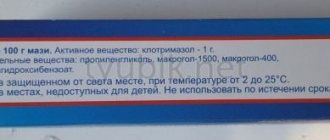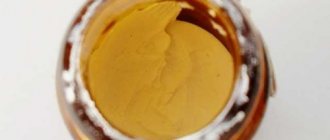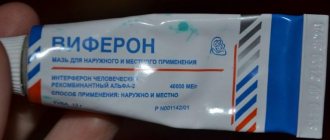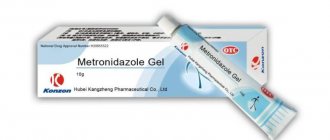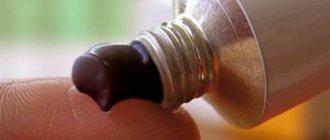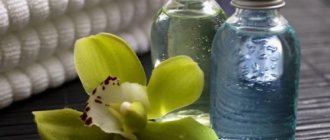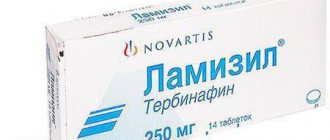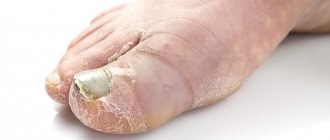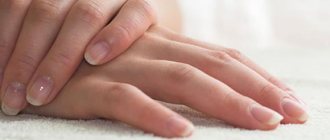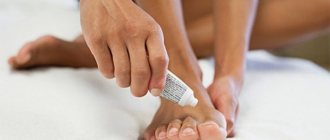Nail fungus, or, as it is also scientifically called, onychomycosis, is a fungal disease that can be treated quite successfully, especially if it is treated in the early stages, and using only external agents. One of the most popular and proven drugs in the fight against this disease is Clotrimazole.
If you follow all the recommendations for the use of this drug, you can be confident that the treatment will be successful. Let us dwell in more detail on how Clotrimazole helps against nail fungus.
Properties and action of Clotrimazole
The active substances included in the drug disrupt the synthesis of the main barrier link of the fungus. Ergosterol is the main structural element of their protective membrane. When it is damaged or destroyed, the protective function of the cell decreases. The permeability of the membrane is impaired, which leads to the death of the pathogen.
In addition, Clotrimazole inhibits the activity of intracellular oxidative enzymes. As a result, the amount of hydrogen peroxide inside the mushroom increases sharply and reaches its maximum point. The cell is destroyed from the inside - the organelles are destroyed, and the foreign organism dies.
The medicinal substance "Clotrimazole" is poorly absorbed through the skin epithelium and mucous membranes, but can accumulate (accumulate) in the superficial and deep layers of the epidermis, which helps in the treatment of fungal infections.
Contraindications
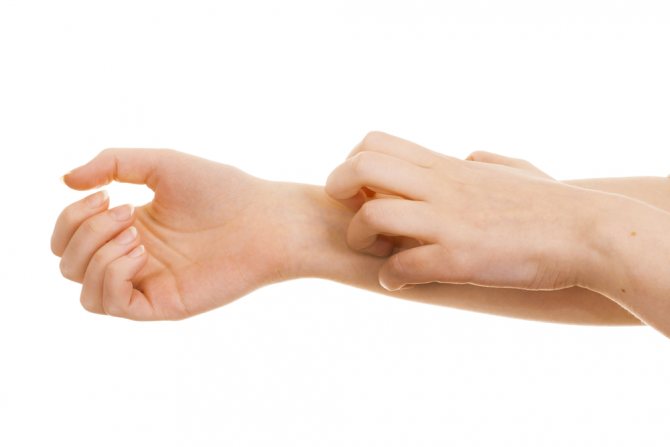
It is necessary to treat nail fungus when the first symptoms and manifestations appear. If the signs of the disease are ignored, the condition worsens. This increases the risk of infecting others. However, it is not recommended to start using Clotrimazole on your own for nail fungus, since the product has a number of contraindications. The most obvious prohibitions on use are:
- hypersensitivity and negative reaction to one or more components of the composition;
- pregnancy, especially the first months;
- Use caution when combining medications while breastfeeding.
Release forms for the treatment of mycosis
Clotrimazole is produced in several variations for external use:
- Cream (emulsion containing water and oil).
- Ointment. It is a homogeneous soft mass that includes a synthetic base and the medicinal substance “Clotrimazole”.
- Powder. Today, this form is not relevant due to its low penetrating ability.
- Solution. Consists of water and dissolved Clotrimazole powder granules.
- Spray. This is a form that includes a solution under pressure. The bottles have a special sprayer.
- Paste (thick consistency ointment). It contains at least 25% powdery substances that remain on the skin for a longer time. Pastes are rarely prescribed, since there are very few pharmacies that produce them.
The drug "Clotrimazole" is also available in the form of gels, suppositories and tablets. They are used for other fungal diseases: mycotic lesions of the genitourinary system, stomatitis, etc.
The algorithm of action and effectiveness of the drug, regardless of the form of its release, are identical; the drugs differ only in price. The variety was created by pharmacologists for ease of use.
It is advisable to apply ointments, creams and solutions to clean and dry skin. It is worth covering not only the affected areas, but also the epithelium around them: this will prevent further “spreading” of the fungus and relapses of dermatological diseases.
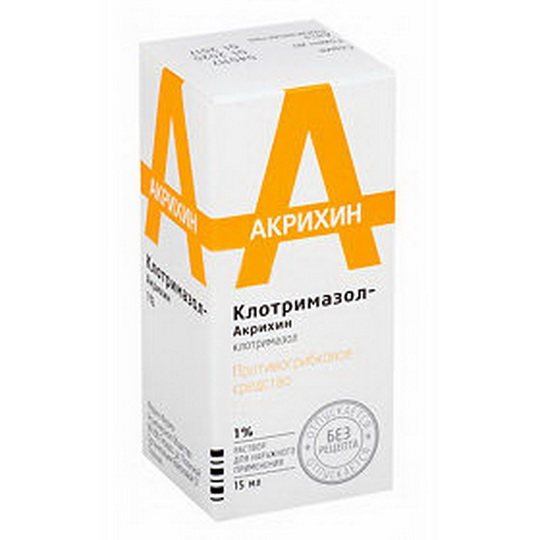
Solution
Available in bottles with a special dispenser.
The solution can be sold in the form of drops. It is forbidden to use them in ophthalmology: if the drug gets into your eyes, you must rinse them thoroughly with plenty of running water.
The solution is used to treat the nail surface and surrounding skin. The foot should be left open to allow the fluid to dry. This form is convenient and quickly absorbed. The expected effect occurs after 1 month of therapy. The cost of the Clotrimazole solution for nail fungus is from 70 rubles.
Cream
It is also applied to the nail plate and the area around it. The therapeutic effect is achieved after 2 months from the start of the drug. The price starts from 150 rubles.
Ointment
A more common form of product production. To make Clotrimazole ointment for foot fungus, you need the active substance and petroleum jelly. These are cheap raw materials, and accordingly, the price of the drug is low - from 60 rubles.
Ointment for nail fungus
Nail fungus is a very common disease in which the nail plates become infected. But the disease is curable, since there are many ointments that will help you get rid of this trouble in a short time. The most common and effective ointments are: nizoral, lamisil, candide, exoderil, zalain, lycospor.
List of antifungal ointments
Nizoral is one of the popular ointments, which gives good results in treatment. The main component of the drug is ketoconazole, which actively destroys pathogenic fungi at the cellular level. From the first days of using this drug, the patient feels significant relief. The ointment is applied in a thin layer to the affected nail and adjacent skin once a day. Treatment lasts more than 2 months depending on the degree of development of the disease. In case of hypersensitivity to the components of the ointment, its use should be discontinued and replaced with another one.
An ointment for nail fungus like Lamisil is one of the safest and most effective pharmaceuticals. It can be used to treat toenails and feet affected by fungus, as well as the nail plates of the hands. The basis of the drug is terbinafine, which actively influences the process of fungal death.
During treatment, the ointment is applied 2 times a day to the surface of the nail plates and the skin adjacent to the nail. The course of treatment is 2-4 weeks. Typically, treatment results are noticeable within 10 days. If this does not happen, then the ointment should be replaced. The advantage of this ointment is that it can be prescribed to children from two years of age. Reasons for discontinuing the drug may be liver disease and individual intolerance to the components of the drug.
An effective antifungal drug is Candida, which is used to treat nail plates and skin. The main component of the drug is clotrimazole, which destroys the membranes of fungi, and this leads to their death. Candide is applied to sore nails twice a day. The duration of treatment depends on the degree of development of the disease. But even after its symptoms disappear, treatment must be continued for a month. The ointment is contraindicated in case of individual intolerance to its components and liver diseases.
An ointment for nail fungus, like exoderil, is also a fairly effective drug. They treat not only nails, but also skin. The basis of the ointment is naftifine hydrochloride, which destroys the cell wall of the fungus. Treatment usually lasts from 2 to 6 months. Once a day, the ointment is applied in a thin layer to the nail plates and adjacent skin. If the drug is poorly tolerated, this is grounds for its discontinuation.
Zalain is popular because it treats not only nails, but also the torso, feet and hands affected by mycosis. The main component of the drug is sertaconazole nitrate, which destroys the cell wall of the fungus, which causes its death. Treatment lasts 2-4 weeks, provided that the patient should lubricate the fungus-affected nails and adjacent tissues 2 times a day. The drug is usually well tolerated. But if there is supersensitivity or intolerance to the components of zalain, the drug should be discontinued and replaced with another.
Mycospor ointment has an effective antifungal effect. Its international name is bifonazole. The ointment has a wide spectrum of action, actively attacks dermatophytes, yeast-like and mold fungi. Contraindication for use is an allergy to the components of the drug.
Caution should be exercised when using ointment during pregnancy
It must be remembered that any antifungal ointment and course of treatment with it must be prescribed by an experienced dermatologist. Self-medication is unacceptable, as it can lead to negative consequences. It should be recalled once again that before the procedure for eliminating nail fungus, you must thoroughly wash your feet with soap and hot water, and then wipe them thoroughly and dry. You can add soda or medicinal herbs to the water. Ointment (cream) – apply a thin layer, rubbing into the nail and periungual skin space. Carefully monitor changes during treatment and inform your doctor about them.
Only through joint efforts with a dermatologist can you achieve positive results and overcome the troubles associated with nail fungus.
Indications for use against fungus on the feet
According to the nosological classification, Clotrimazole is used to treat the following skin diseases of the feet:
- Dermatophytosis (dermatomycosis). This is a group of skin infectious pathologies caused by fungi of certain genera: Trichophyton
,
Microsporum
and
Epidermophyton
. Most often, the anomaly is localized on the big toes and little toes. - Candidomycosis. One of the types of fungal infection. Affects nails and skin of the feet. Etiology – microscopic opportunistic yeast-like fungi of the genus Candida
. - Interdigital mycotic erosion. The fungus damages the upper layer of the epithelium down to the basement membrane. After treatment, the wound surface heals without leaving any traces.
- Mycotic paronychia. An inflammatory process in or under the nail cuticle, caused by various fungi.
- Mold. It is a type of fungal infection. The pathogens are aggressive and difficult to treat.
All of these diseases are caused by various pathogens. Clotrimazole is a broad-spectrum antifungal drug, so it is very effective in getting rid of toenail fungus.
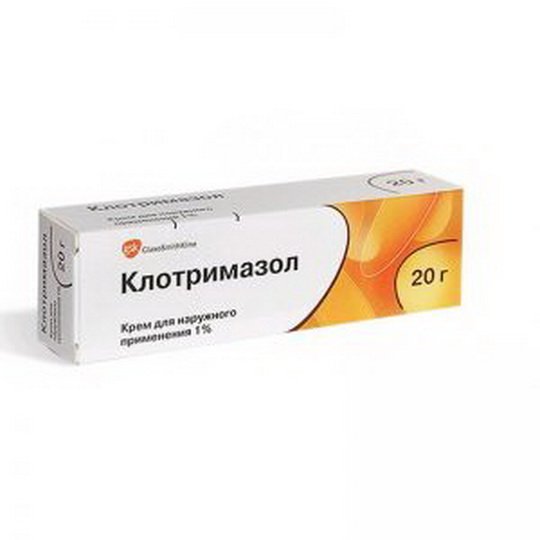
The principle of action of the drug
For their vital functions, fungal formations produce ergosterol, which helps them withstand the effects of the external environment. When Clotrimazole comes into contact with fungal cells, small holes appear in the membrane. After some time, fungal formations lose their ability to divide and begin to fade away.
The drug has the following properties:
- antiseptic;
- antimicrobial;
- antifungal.
Many people ask dermatologists whether it is possible to cure nail fungus with Clotrimazole? It is possible, but the treatment process is quite long and requires patience. The drug is used only for external treatment of fungal infections, this is clearly written in the attached instructions.
Treatment of nail fungus with Clitrimazole should be carried out three times a day for two months. You should not expect an immediate cure; the timing of therapy depends on the area of the affected area, the characteristics of the disease and the advanced state of the disease. At first, when treating with the drug, the growth of the fungal formation slows down, and only then it is removed.
Instructions for use
Frequency of use of Clotrimazole: the drug in any release form is applied to the affected area at least 2-3 times a day.
The duration of treatment for foot fungus is from 2 to 4 weeks. If no improvement in the clinical picture is observed within a month, then a microbiological study is required. Based on the results obtained, either this diagnosis is confirmed or differential diagnosis with other diseases is carried out.
Clotrimazole for nail fungus is applied to clean, dry skin. After this, you should not put on socks or shoes until the medicine is completely absorbed.
After contact with affected skin, it is advisable to wash your hands thoroughly to prevent the fungal infection from spreading to other areas of the body. Maintaining personal hygiene is the basis for the prevention of dermatomycosis and other diseases.
Preparation for application
First you need to detect all affected nail plates and skin. Feet should be washed with soap and dried. Now you can apply the drug.
After hygienic cleaning of the feet, it is recommended to thoroughly wipe and dry the skin. Soap is lye. The effectiveness of antifungal agents in such an environment is sharply reduced.
Foot baths before using Clotrimazole are very useful. The procedure is quick, but it speeds up the process of destroying the fungus. It will help relieve skin irritation and swelling.
The simplest recipe for a foot bath: add tar soap and a couple of tablespoons of sea salt to a basin of warm water, soak your feet in it for 10-15 minutes. Salt will relieve swelling of the feet, and tar soap will have an antimicrobial effect.
After steaming the feet, necrotic (dead) tissue and the most problematic areas of the nail are removed using nail scissors or a nail file. The softened stratum corneum is easier to remove. In the treated field, the active medicinal substance penetrates deeper and faster.
After each procedure, used instruments are disinfected.
Clotrimazole is applied to the prepared area of skin and nail.
Indications for use of clotrimazole
As mentioned above, strict adherence to the instructions for use of the drug and the instructions of the attending physician are the key to successful treatment of onychomycosis. Therefore, it is strongly not recommended to stop treatment as soon as the symptoms of infection disappear. This is an absolutely wrong decision, which can lead to a quick relapse. The course of therapy should be completed in full. Only in this case can the disease be forgotten forever.
The main indications for the use of clotrimazole are the following fungal infections:
1. Onychomycosis of nails. 2. Mycoses of skin folds and feet. 3. Pityriasis versicolor (varicolored) lichen. 4. Erythrasma. 5. Pyodermatitis.
There are cases when patients consult a doctor due to the low effectiveness of the prescribed medication. In such a situation, you should not get excited and accuse the dermatologist of incompetence. The reason for the ineffectiveness of treatment may be resistance to antifungal medications or non-compliance with recommendations for the use of the drug. In order to make sure that the prescribed therapy is correct, you can visit a special laboratory and have a scraping tested for sensitivity to antimycotic drugs.
Side effects
When using any product, unwanted effects may occur. After applying Clotrimazole, sometimes there is a burning sensation, swelling, irritation or peeling of the skin. In rare cases, intense redness, blistering and parasthesia (sensitivity disorder manifested by sudden crawling sensations or slight tingling sensations) are observed.
In case of individual intolerance, an allergic reaction may begin, including hives and severe itching.
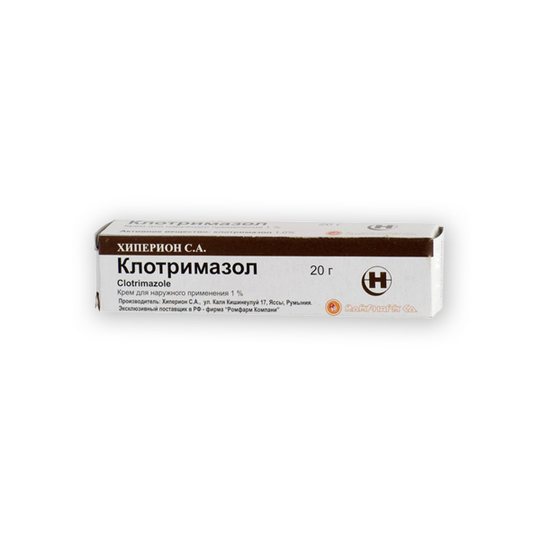
Treatment of fungus with Clotrimazole: ointment, suppositories, tablets. Instructions and reviews
Clotrimazole is a universal remedy for the treatment of all types of fungus, which is sold in the form of vaginal capsules, suppositories, and topical preparations (ointments, creams, gels). It is very popular among dermatologists and with its help they successfully cure urogenital mycosis in women and men, fungus in children, various types of lichen and other dermatitis caused by pathogenic fungal microorganisms.
Release forms
Clotrimazole is a potent antimycotic medicine. Available in several forms:
- ointment, gel, cream, spray, powder – for external use in the treatment of skin mycoses (nail fungus, hand fungus, etc.);
- vaginal suppositories, capsules - for the sanitization of the birth canal and the fight against genital fungus, as well as infections of the genital organs caused by fungi of the genus Candida.
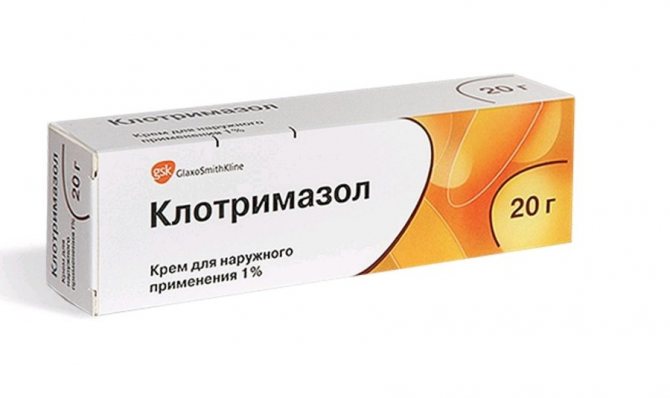
Composition, pharmacodynamics, pharmacokinetics
The drug contains the main active ingredient – clotrimazole. The manufacturer uses as auxiliary components:
- benzyl alcohol;
- ethoxylated sorbitan;
- pyrogen-free water;
- octyldodecanol;
- spermaceti (synthetic).
Pharmacodynamics
The drug is a synthetic antimycotic, antitrichomonas drug belonging to the imidazole group. The action of Clotrimazole is to stop the production of ergosterol, which is required for the development of the cytoplasmic membrane of microorganisms. This provokes its destruction, resulting in cell lysis.
Clotrimazole also accelerates vacuolar degeneration, increases the level of lipocarrying capacity of the phospholipid membrane, and also reduces the number of non-membrane organelles - ribosomes. In addition, the drug inhibits the activity of peroxidases, which accelerates the accumulation of hydrogen peroxide at the cellular level.
The medicine helps in the fight against various fungal infections, including dermatophytes, staphylococci, trichomonas, and yeast microorganisms.
Pharmacokinetics
When treated with vaginal tablets or suppositories, absorption of the active substance ranges from 3 to 10% of the administered dose. The concentration of clotrimazole in the blood and vaginal secretions lasts up to three days. The drug is quickly converted by the liver into inactive metabolites.
Clotrimazole for skin fungus
To cure fungal infections that affect the skin, topical preparations are used:
- ointment;
- spray;
- powder;
- gel;
- cream.
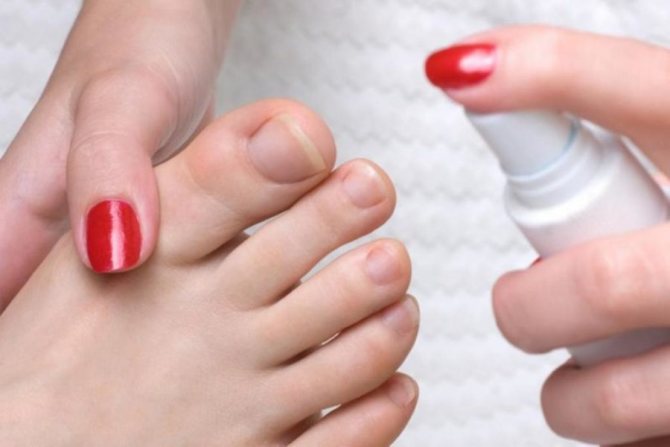
The listed products are quickly absorbed into the epidermal layers, after which they destroy fungal formations in a short period of time.
Medicines for external use have a wide spectrum of action. They can fight almost all types of mycoses and bacteria that provoke the development of various infectious skin diseases. Clotrimazole is mainly used to treat:
- mycosis of the feet, fingers and other parts of the body;
- onychomycosis (fungus of the nail plate);
- microsporia;
- diaper rash;
- lichen of all types (ringworm, shingles, multicolored).
To combat a fungal infection, it is necessary to smear Clotrimazole on the site of the disease at least twice a day. The duration of treatment depends on the stage of development of the disease and the size of the affected area of the epidermis. It usually takes about 10 days for tinea or foot fungus to heal. In some especially severe cases, therapy is delayed for more than 30 days.
To speed up the healing process, you must follow the advice of dermatologists:
- Before each application of Clotrimazole, you should thoroughly wash the skin surface with clean water and soap, and also treat it with an antiseptic, such as hydrogen peroxide or simple alcohol;
- it is necessary to support your immunity with the help of a proper diet, which should include vegetables and fruits;
- it is required to keep the room clean, regularly wash the floors, and ventilate the home;
- We must not forget about personal hygiene and take a shower and wash things more often.
Substitutes for Clotrimazole (for external use) are:
- Bifosin cream;
- Exoderil;
- Mycozone;
- Salicylic acid;
- Candide;
- Amyclone;
- Akrikhin "Akriderm".
They all have the same effect, the difference lies in the set of contraindications, side effects and the cost of the medicine at the pharmacy.
Vaginal suppositories for women
Suppositories and suppositories Clotrimazole are used in the treatment of many vaginal infections and fungal diseases:
- candidiasis;
- trichomoniasis;
- bacterial, viral vaginitis;
- chlamydia.

The medicine is inserted into the vagina to the depth of half the index finger 1-2 times a day. The active substance of the drug quickly penetrates the mucous membrane and adversely affects the fungal infection, as a result of which it loses its ability to exist and is destroyed. The result is visible after the first use of Clotrimazole, and complete recovery occurs after 6 days.
To enhance the effect of using intravaginal suppositories, the doctor must prescribe complex therapy, which is supplemented by:
- vitamins;
- medications to restore intestinal microflora;
- immunomodulatory, antifungal tablets (Levorin, Nystatin, Pimafucin);
- intravenous injections.
Recommendations for treatment:
- before each insertion of vaginal suppositories, you need to wash the groin area;
- you should avoid tight synthetic underwear and give preference to loose cotton panties;
- It is forbidden to douche, as this procedure may kill the bacteria that regulate the development of the fungus;
- You need to start eating right and taking vitamin complexes.
The following drugs have similar properties of Clotrimazole vaginal capsules:
- Vagiclin;
- Candide;
- Fungisan;
- Kandibene;
- Clomesol.
Treatment of urogenital candidiasis in men
Despite the fact that thrush is a female disease, it also affects the male genitals. It appears due to a decrease in the body’s protective functions and neglect of the rules of intimate hygiene. You can also get this disease through unprotected sexual intercourse with an infected partner.
To get rid of thrush in men, Clotrimazole ointment is used, which must be applied to the head of the penis and foreskin at least 2 times a day. The duration of therapy is about one week.
Along with the use of topical drugs, the patient is prescribed probiotics, antifungal, and immunomodulatory drugs. Comprehensive treatment speeds up the healing process and prevents recurrence of fungal infection.
Contraindications and side effects
Like any other medicine, Clotrimazole suppositories and ointment have a number of contraindications for use:
- allergy to the composition of the drug;
- first three months of pregnancy;
- breastfeeding (according to doctor's indications);
- acute liver diseases.
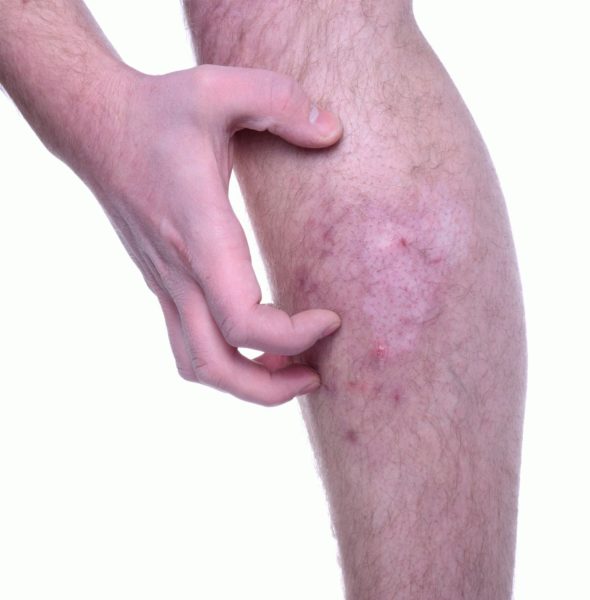
Side effects include peeling, redness, irritation of the skin, burning sensation in the genital area (for men), heavy vaginal discharge, swelling of the mucous membranes, and frequent urge to urinate.
Reviews from patients and doctors
Elena, 34 years old.
For a long time I suffered from cheesy vaginal discharge, which was accompanied by an unpleasant odor. I tried a lot of medications, from cheap drugs to high-priced medications, but they did not bring a positive result. As a result, I stopped self-medicating and went to see a gynecologist. After tests, I was diagnosed with vaginal candidiasis. The doctor prescribed the use of Clotrimazole suppositories. A week later, all the symptoms of this unpleasant disease disappeared. The only thing that scared me was the heavy discharge that appeared after the first use of the drug, but as it turned out, this was a completely normal phenomenon.
Alexander, 29 years old.
I love animals very much and often come into contact with them on the street. After another feeding of stray cats, I discovered scaly, oval-shaped spots on my fingers and toes that quickly grew in diameter and also itched terribly. It was lichen. I have long known about the effectiveness of Clotrimazole ointment for fungus, but there was no reason to use it yet. And now that time has come. I began to regularly lubricate the lichen formations with ointment, and after 5 days they disappeared. I didn’t even expect such a quick result!
Valery Tokhtiyarov, dermatologist.
I have been treating skin diseases for a long time, of which fungal infections account for almost 70%. Clotrimazole is the most effective remedy today that can fight a wide range of fungi. Despite the presence of a huge number of analogues of this drug, only the original medicine can in a short time relieve the patient of all types of lichen, nail fungus, foot fungus and other types of mycosis. Due to the small number of side effects, I allow the use of Clotrimazole without prior consultation with a specialist, but I strongly recommend that you read the instructions for the drug before doing so.
Video on topic
Pros and cons of using
The use of Clotrimazole as an antifungal drug has its positive and negative sides.
| pros | Minuses |
| High efficiency | In very rare cases, an allergic reaction is possible |
| Possibility of treating both local manifestations of fungal infection and systemic mycoses | Duration of antifungal therapy – from 1 to 4 months |
| Safe composition | Creams and ointments are poorly absorbed |
| Few side effects | Do not use in the first trimester of pregnancy and during lactation |
| Affordable price | |
| Can be used by children from infancy |
Analogs
Drugs similar in their effect on pathogenic pathogens of fungal infections include:
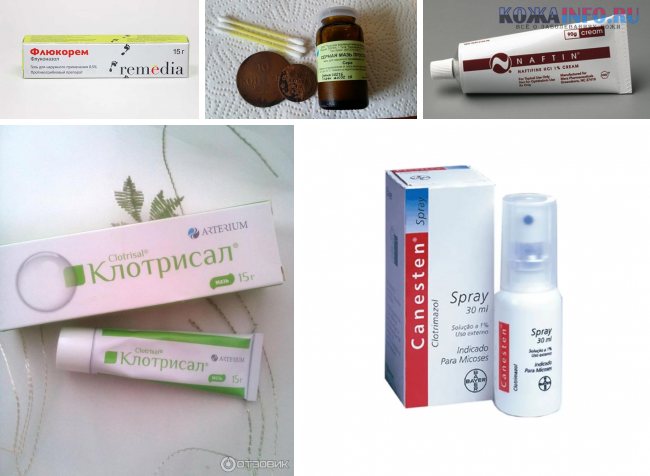
Clotrisal , manufactured in the form of an ointment with a whitish tint and a dense structure, with Clotrimazole as a key component. To enhance effectiveness, salicylic acid has been added to the drug.
Sulfur ointment belongs to the category of inexpensive products. It is a homogeneous mixture with a yellowish tint. The key component of the ointment is sulfur, which begins to work when it comes into contact with the epidermal layers of the skin.
Canesten spray with Clotrimazole as the base compound. The release is made in the form of a yellowish transparent liquid. A sprayer is installed on the bottle to evenly apply the substance to the damaged areas.
Fluconazole ointment with the active ingredient of the same name is produced in the form of a transparent gel of high viscosity.
Naftifine cream is represented by a homogeneous whitish substance with a key component in the form of naftifine hydrochloride with the addition of organic alcohol.
Price and analogues
There are enough antimycotic agents on the pharmaceutical market. However, Clotrimazole against nail fungus is the most popular. Patients prefer it mainly because of its low cost: from 50 to 300 rubles, depending on the form of release.
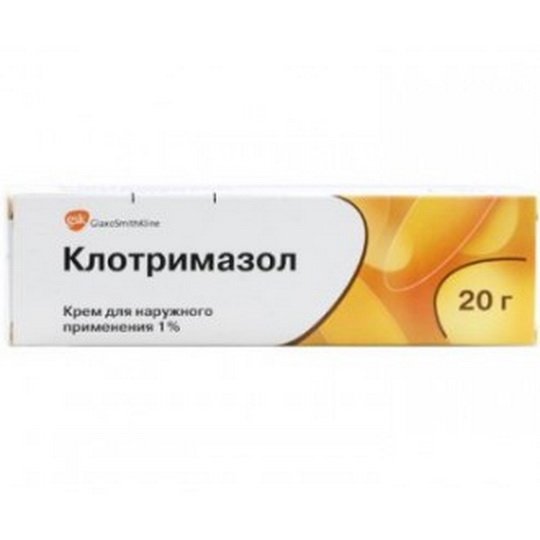
Clotrimazole has several analogues. In addition to it, the following Russian-made products can be prescribed for the treatment of fungal skin diseases:
- Sulfuric ointment.
- Isol.
- Amyclone.
- Clomegel.
- Akriderm GK.
Imported analogues of Clotrimazole for toenail fungus:
- Candide (India).
- Triderm (USA).
- Kandibene (Germany).
- Metrogil (India)
The price of these drugs usually exceeds the cost of the original drug. According to doctors' reviews, Clotrimazole ointment for nail fungus is more effective than its analogues. However, it should be remembered that there are patients with individual intolerance to the ingredients of Clotrimazole. They are forced to replace it with other means.
Composition and pharmacological properties
The active substance of the drug is clotrimazole.
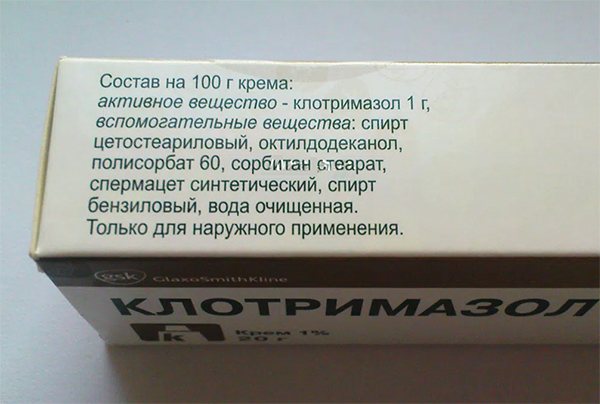
It also contains other components:
- propylene glycol (solution, ointment);
- petrolatum;
- ethanol (solution);
- polyethylene glycol (solution);
- wax esters;
- water;
- benzyl, stearic, cetyl alcohols;
- methylparaben (ointment);
- polyethylene oxide (ointment);
- polysorbate 604.
The main purpose of Clotrimazole is to stop the release of ergosterol, with the help of which fungi become resistant to the effects of many components of antifungal agents. Ergosterol protects fungal cells from the influence of external factors that interfere with the functioning of fungi.
The medicine creates holes in cell membranes, causing cell division to stop. This leads to their complete destruction.
Clotrimazole has the following properties:
- antimicrobial;
- tanning;
- antifungal;
- disinfectant.
The drug fights against any manifestations of fungus. Its components penetrate deeply into the affected fingernails and toenails, which allows recovery in a relatively short time.
How to use Clotrimazole for nail fungus. Reviews
Onychomycosis is a fungal nail disease that can be effectively treated with external agents in the early stages.
The patient uses ointments, gels, creams and solutions daily and for a long time, since the success of therapy is determined not only by the disappearance of external signs of mycosis, but also by the absence of fungal colonies in the structure of the plate.
Let's look at how Clotrimazole helps against nail fungus and how to use this medicine correctly.
Clotrimazolum: composition and release form
The release form of Clotrimazole is presented in several variations:
- Gel.
- Cream.
- Ointment.
- Solution.
- Vaginal tablets and suppositories.
All forms of the drug, except vaginal, are suitable for the treatment of onychomycosis.
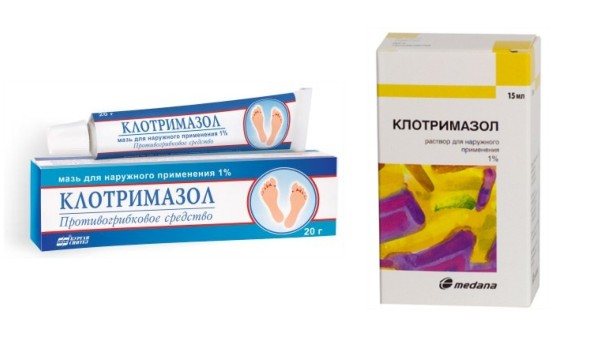
The active component of Clotrimazole is the substance of the same name, the share of which in the composition of various forms of the drug is 1%. The set of additional substances is determined by the specific form of release of the antimycotic. For example, the gel contains glycerol, carbomer, propylene glycol, and sage essential extract.
In addition to clotrimazole, the cream contains substances such as synthetic spermaceti, sorbitan stearate, benzyl and cetostearyl alcohols, and water. The ointment formula consists of clotrimazole, nipagin, propylene glycol, methylparaben and polyethylene oxides. Clotrimazole solution contains ethanol 96%, polyethylene glycol 400, propylene glycol.
As an imidazole derivative, clotrimazole is aggressive against fungi that can complicate the course of infectious processes. These are:
- Dermatophytes (Microsporum, Trichophyton, Epidermophyton floccosum).
- Dimorphic strains (Darling's fungus Histoplasma capsulatum, the causative agent of coccidioidomycosis, a species of fungal flora Paracoccidicides brasiliensis, causing paracoccidioidomycosis).
- Yeast-like fungi (candida, cryptococcus neofomens).
In some cases, dermatologists prescribe Clotrimazole in combination with Hydrocortisone cream. A gentle corticosteroid effectively eliminates inflammation and pain caused by fungal infection.
Pharmacological features of Clotrimazole
Clotrimazole is one of the broad-spectrum drugs. Doctors prescribe it for various pathological conditions associated with fungal damage to the body. Leaving reviews on the treatment of nail fungus with Clotrimazole, dermatologists write that for onychomycosis it is better to use the liquid form of the drug.

Thanks to its light structure, it is quickly absorbed by the stratum corneum of the nail. Active substances accumulate in the plate, heal it and protect it from further development of infection.
How does Clotrimazole affect the fungus? Pharmacists explain the therapeutic effect by the ability of the active component to block the synthesis of substances necessary for the creation of cell membranes of onychomycosis pathogens. A deficiency of protein, ergosterol and nucleic acid does not allow parasites to develop, so their cells are destroyed and the pests themselves die.
Clotrimazole enters the systemic circulation in minute quantities. It does not affect the vital functions of the human body. The substance breaks down in the liver into inactive units and leaves the body through the excretory system.
In addition to fungal diseases, Clotrimazole effectively eliminates other infectious conditions whose pathogens are resistant to nystatin and other antifungal agents.
How to use Clotrimazolum for nail fungus
Before starting treatment, it is necessary to study the instructions for use of Clotrimazole, whether it is an ointment for a fungus or another dosage form. The abstract will provide complete information about the antimycotic and teach the correct use of the medication.
The treatment regimen for onychomycosis with a solution, ointment or cream containing clotrimazole looks like this:
- The affected limb is thoroughly washed and rinsed to remove soap residue.
- The hand or foot is steamed with hot water and the problem areas of the nail are removed with scissors and a nail file (in the steamed state, the affected area is removed more easily, and besides, medicinal substances penetrate instantly into the softened plate).
- A small amount of the drug is applied to the prepared area and gently rubbed into the surrounding skin to prevent the spread of mycosis.
- Sessions are held for 2 – 3 p.m. per day. No bandages are applied.
- Therapy is carried out until tests show a negative result.
- Used instruments are disinfected after each procedure and thrown away after recovery.
To obtain a lasting result without relapse, Clotrimazole solution against nail fungus is used for 2 to 7 weeks. The same duration of therapy is recommended when using other forms of antimycotic agents.
Doctors prescribe different forms of Clotrimazole to pregnant women only from the second trimester of gestation. During lactation, the drug is prescribed carefully, weighing the pros and cons of treating the fungus with medication.
External forms of Clotrimazole are not prescribed to children for the treatment of onychomycosis due to the lack of experience in use and clinical trial data. Vaginal tablets based on clotrimazole are prescribed to girls after 12 years of age, subject to the presence of menstruation.
When used externally, Clotrimazolum is safe in terms of overdose, since it is absorbed into the bloodstream in small proportions. If accidentally ingested, the drug causes hallucinations, nausea, vomiting, drowsiness, gastralgia and liver dysfunction. Treatment in this case will be symptomatic.
Video:
Side effects, contraindications and analogues of Clotrimazole
Side effects when using Clotrimazole may include itching, blistering, erythema, tingling sensation, swelling or peeling of the skin. The body of a particularly sensitive patient may react to the antimycotic with severe symptoms of urticaria.
Doctors consider only individual intolerance to the components of the drug to be a contraindication to the use of Clotrimazole and, in this case, suggest replacing it with analogues:
- Batrafen.
- Mikozan.
- Lamisil.
- Amyclone.
- Kanesten.
- Kandibene.
- Funginal, etc.
